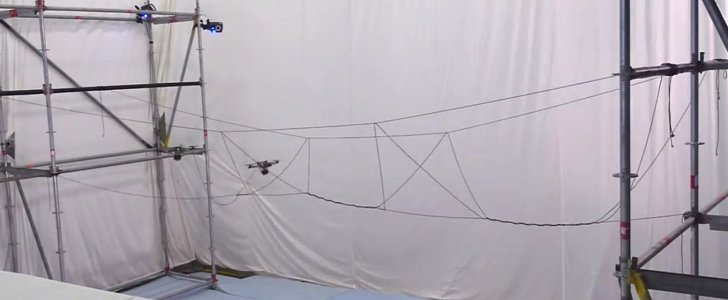It may turn up as a game changer, but what if we could use the same drones people spy on their neighbors for something useful for a change? What if we could build a bridge strong enough that would allow a person to walk across it? It’s what researchers at the ETH Zurich Flying Machine Arena in Switzerland have recently accomplished, and it’s quite impressive.
Turns out all the marketing talks the commercial UAVs makers keep spreading come in handy after all. Hey, if you really want to make something good out of a gizmo, you first need to make sure there’s a market for it, that it is popular among regular customers. With that many drones being flown all over the place, we believe it’s safe to say the time has come to get to the next level.
The video you see below is part of a body of research in aerial construction, the industry of building structures with the aid of flying machines. Aside from the required anchor points at both ends of the bridge, which are made of metal, the structure consists exclusively of tensile elements and its connections and links are entirely realized by flying machines.
Spanning 7.4 m (24 feet) between two scaffolding structures, the bridge consists of nine rope segments for a total length of about 120 m (393 feet). It’s composed of different elements such as knots, links, and braids, but the main material used is called Dyneema. It has a low weight-to-strength ratio and thus is suitable for aerial construction. With little weight (7 g per meter / 0.24 ounces per 3.2 feet), a 4 mm (0.15 inches) diameter rope can sustain 1,300 kg (2,866 lbs).
In what concerns the drones, you’ll want to know they are equipped with a motorized spool that allows them to control the tension acting on the rope during deployment. A plastic tube guides the rope to the release point located between two propellers.
The arena features a motion capture system that provides vehicle position and attitude measurements. Algorithms are run on a computer and commands are then sent to the flying machines via a customized wireless infrastructure.
There’s more to it than the details we’ve listed above, so if we’ve managed to tackle your interest, you could check out the project’s website for further information.
The video you see below is part of a body of research in aerial construction, the industry of building structures with the aid of flying machines. Aside from the required anchor points at both ends of the bridge, which are made of metal, the structure consists exclusively of tensile elements and its connections and links are entirely realized by flying machines.
Spanning 7.4 m (24 feet) between two scaffolding structures, the bridge consists of nine rope segments for a total length of about 120 m (393 feet). It’s composed of different elements such as knots, links, and braids, but the main material used is called Dyneema. It has a low weight-to-strength ratio and thus is suitable for aerial construction. With little weight (7 g per meter / 0.24 ounces per 3.2 feet), a 4 mm (0.15 inches) diameter rope can sustain 1,300 kg (2,866 lbs).
In what concerns the drones, you’ll want to know they are equipped with a motorized spool that allows them to control the tension acting on the rope during deployment. A plastic tube guides the rope to the release point located between two propellers.
The arena features a motion capture system that provides vehicle position and attitude measurements. Algorithms are run on a computer and commands are then sent to the flying machines via a customized wireless infrastructure.
There’s more to it than the details we’ve listed above, so if we’ve managed to tackle your interest, you could check out the project’s website for further information.

